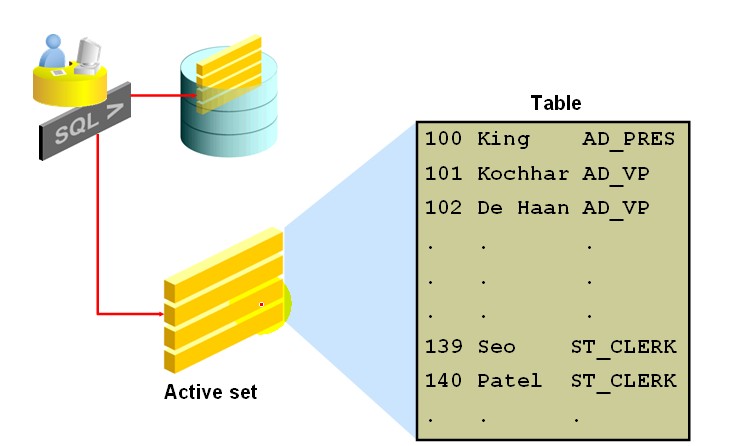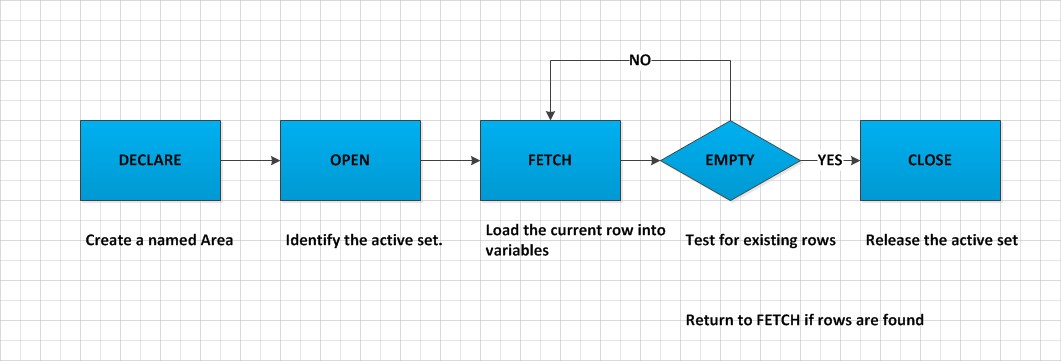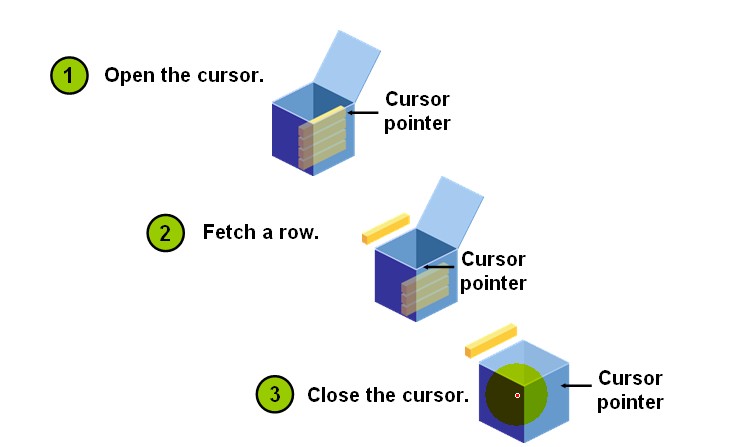Objectives
After completing this lesson,you should be able to do the following:
- Distinguish between implict and explicit cursors
- Discuss the reasons for using explicti cursors
- Declare and control explicit cursors
- Use simple loops and cursor FOR loops to fetch data
- Declare and use cursors with parameters
- Lock rows with the FOR UPDATE clause
- Reference the current row with the WHERE CURRENT OF clause
- USE BULK COLLECT to retriveve multiple rows of data with a single statement.
Agenda
- What are explicit cursors?
- Using explicit cursors
- Using cursors with parameters
- Locking rows and referencing current row
- Use BULK COLLECT to retrieve multiple rows of data with a single statement
Cursors
Every SQL statement that is executed by the Oracle Server has an associated individual cursor:
- Implicit cursors:declared and managed by PL/SQL for all DML and PL/SQL SELECT statements
- Explicit cursors:declared and managed by the programmer

Explicit Cursor Operations

Controlling Explicit Cursors


Declaring the Cursor
- Syntax:
CURSOR cursor_name IS SELECT statement;
- Examples:
 Cursor without variables
Cursor without variables
DECLARE CURSOR c_emp_cursor IS SELECT employee_id,last_name FROM employees WHERE department_id = 30;
 Cursor with variable
Cursor with variable
DECLARE v_locid NUMBER := 1700; CURSOR c_dept_cursor IS SELECT * FROM dept WHERE location_id = v_locid;
Opening the Cursor
 Open Cursor
Open Cursor
DECLARE CURSOR c_emp_cursor IS SELECT employee_id,last_name FROM employees WHERE department_id = 30; ... BEGIN OPEN c_emp_cursor;
Fetching Data from the Cursor
DECLARE --声明游标 c_emp_cursor CURSOR c_emp_cursor IS SELECT employee_id,last_name FROM employees WHERE department_id = 30; --declare variables v_empno and v_lname v_empno employees.employee_id%TYPE; v_lname employees.last_name%TYPE; BEGIN OPEN c_emp_cursor; FETCH c_emp_cursor INTO v_empno,v_lname; DBMS_OUTPUT.PUT_LINE(v_empno || '->' || v_lname); END; /
DECLARE --声明游标 c_emp_cursor CURSOR c_emp_cursor IS SELECT employee_id,last_name FROM employees WHERE department_id = 30; --declare variables v_empno and v_lname v_empno employees.employee_id%TYPE; v_lname employees.last_name%TYPE; BEGIN OPEN c_emp_cursor; LOOP FETCH c_emp_cursor INTO v_empno,v_lname; EXIT WHEN c_emp_cursor%NOTFOUND; DBMS_OUTPUT.PUT_LINE(v_empno || '->' || v_lname); END LOOP; CLOSE c_emp_cursor; END; /
Closing the Cursor
... LOOP FETCH c_emp_cursor INTO empno,lname; EXIT WHEN c_emp_cursor%NOTFOUND; DBMS_OUTPUT.PUT_LINE(v_empno || ' ' || v_lname); END LOOP; CLOSE c_emp_cursro; END; /
Cursors and Records
Process the rows of the active set by fetching values into a PL/SQL record.
 View Code
View Code
DECLARE CURSOR c_emp_cursor IS SELECT employee_id,last_name FROM employees WHERE department_id = 30; v_emp_record c_emp_cursor%ROWTYPE; BEGIN OPEN c_emp_cursor; LOOP FETCH c_emp_cursor INTO v_emp_record; EXIT WHEN c_emp_cursor%NOTFOUND; DBMS_OUTPUT.PUT_LINE(v_emp_record.employee_id || '--->' || v_emp_record.last_name); END LOOP; CLOSE c_emp_cursor; END; /
基于表锁定和基于游标锁定;
